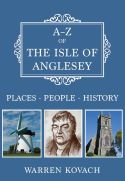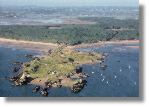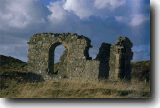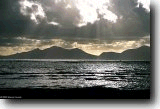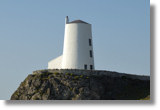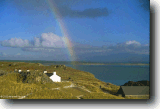Llanddwyn Island
Llanddwyn Island (Ynys Llanddwyn) is a magical place. Located at the far end of a pleasant beach near Newborough Warren, this narrow finger of land is an ideal picnic site during fine weather, but also an exhilarating place when the winter winds blow. Its rolling dunes, large rock outcrops and mixture of historic buildings makes it an ideal place for an afternoon of exploration.
Llanddwyn is not quite an island. It remains attached to the mainland at all but the highest tides. It provides excellent views of Snowdonia and the Lleyn Peninsula and is part of the Newborough Warren National Nature Reserve. You can find Llanddwyn Island with this map or see an aerial view on Google Maps.
St. Dwynwen
Nothing wins hearts like cheerfulness - St. Dwynwen
The name Llanddwyn means "The church of St. Dwynwen". She is the Welsh patron saint of lovers, making her the Welsh equivalent of St. Valentine. Her feast day, 25 January, is often celebrated by the Welsh with cards and flowers, just as is 14 February for St. Valentine.
Dwynwen lived during the 5th century AD and was one of 24 daughters of St. Brychan, a Welsh prince of Brycheiniog (Brecon). She fell in love with a young man named Maelon, but rejected his advances. This, depending on which story you read, was either because she wished to remain chaste and become a nun or because her father wished her to marry another. She prayed to be released from the unhappy love and dreamed that she was given a potion to do this. However, the potion turned Maelon to ice. She then prayed that she be granted three wishes: 1) that Maelon be revived, 2) that all true lovers find happiness, and 3) that she should never again wish to be married. She then retreated to the solitude of Llanddwyn Island to follow the life of a hermit.
Dwynwen became known as the patron saint of lovers and pilgrimages were made to her holy well on the island. It was said that the faithfulness of a lover could be divined through the movements of some eels that lived in the well. This was done by the woman first scattering breadcrumbs on the surface, then laying her handkerchief on the surface. If the eel disturbed it then her lover would be faithful.
Visitors would leave offerings at her shrine, and so popular was this place of pilgrimage that it became the richest in the area during Tudor times. This funded a substantial chapel that was built in the 16th century on the site of Dwynwen's original chapel. The ruins of this can still be seen today.
Maritime History
Llanddwyn Island is situated near the southern entrance to the Menai Strait. As a result it became important as shipping of slate from the ports of Bangor, Caernarfon and Felinhelli increased. A beacon, called Tŵr Bach, was built at the tip of the island to provide guidance to ships heading for the Strait. Another more effective lighthouse, Tŵr Mawr, which was modelled on the windmills of Anglesey, was built nearby in 1845. The older lighthouse has now returned to service after a modern light was placed on top.
During this time cottages were built near the towers to house pilots who guided ships into the Strait. Two of these cottages have been restored, with one housing an exhibition about the local wildlife. From 1840 a lifeboat was also stationed there. It was manned by the pilots as well as volunteers from Newborough; the cannon that was used to summon the lifeboat crew can still be seen near the cottages. During its time up to the closure in 1903 the lifeboat from here saved 101 lives in 35 separate incidents.
Natural History
Llanddwyn Island is part of the Newborough Warren National Nature Reserve. The dunes, mudflats and saltmarshes of the reserve support a wide range of plants and invertebrates. The flowers found on the Island include herb-robert (Geranium robertianum), bird's-foot trefoil (Lotus corniculatus), thrift (Armeria maritima), bluebells (Hyacinthoides non-scripta) and yellow horned poppies (Glaucium flavum).
The cliffs around the island support a wide variety of nesting seabirds, including cormorants, shags and oystercatchers. Ynys yr Adar (Bird Rock), a small islet off the tip of Llanddwyn, throngs during the spring with one percent of the total British breeding population of cormorants. Waders such as turnstones and sandpipers are found along the coast and terns can be seen fishing in the bay. The mammal population is supplemented by a flock of the unusual Soay sheep that graze near the chapel.
As you approach the island you pass between several large rocks in the sand. These are pillow lavas, part of the Precambrian Gwna Group. These mounds of rock were formed by undersea volcanic eruptions; as the hot molten rock met the cold seawater a ballon-like skin was formed, which then filled with more lava, forming the characteristic pillow shape. These extend down much of the length of Llanddwyn Island, giving it its interesting rolling topography, and are also found in many other places around Anglesey.
Also see:
Panoramas of Llanddwyn Island
A new book by Warren Kovach, author of this web site
